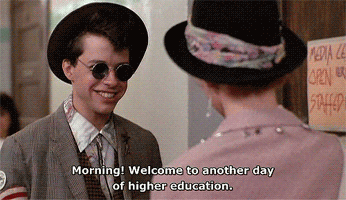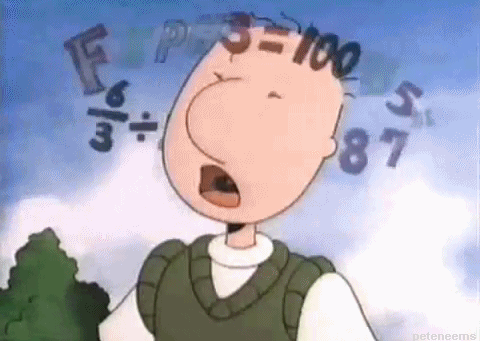College applications can be due any time from November to January each year, depending on if you choose to apply early or regular decision. If you’re applying to a school that has rolling admissions, you may even be able to submit an application during the summer after graduation and still receive a spot for the fall semester. Most likely, however, if you’re a high school senior, a college student thinking about transferring, or an adult thinking about heading back to school, it’s application crunch time.

Pretty in Pink / Giphy
The college application is actually a joint effort between you, your current institution, and your teachers, advisors, counselors, or employers.
- You are required to submit the actual application, writing samples, and a description of your activities (similar to what you’d find on a résumé).
- Your institution(s) will have to send your high school (and college) transcripts to your prospective institutions.
- Your teachers and counselors, then, are responsible for writing letters of recommendation.
While your school and your recommenders do have some degree of responsibility, it is your job to ensure that everything makes it to your prospective institutions on time. You must ask your school and your recommenders well in advance, provide them with the necessary materials (addresses and envelopes, for example), and follow up with them.
Your main focus, however, should be on completing the fill-in-the-blank portion of your applications, submitting good writing samples, making sure that your activities section is complete and accurate, and sending in your standardized test scores.
The Fill-in-the-Blank Portion
This is where you input your name, home address, and contact information. You must also list the institutions you’ve attended so far. As a high school student, you’ll list just your high school(s) and any institution where you dual-enrolled (taking college-level courses for high school credit, for example). Anybody with any postsecondary experience will, of course, include the name of their postsecondary institution as well as their high school. You may also be asked to input your GPA, current class schedule, and information about your family. The majority of this is background information and will be supplemented by your transcripts.
Writing Samples

The Simpsons / Giphy
Writing samples are the most dreaded part of a college application. Typically, schools will ask for at least one personal essay and several short answer responses. The actual requirements may be more or less depending on the schools to which you are applying. Schools that use an application platform (the Common, Coalition, or Universal College application) may choose to use the associated essay questions, supply supplemental questions, or both. Your submissions for your personal essay and short answer questions are going to show colleges who you really are. You want to use this time to be honest and to show off a part of you that may not shine through in the rest of your application. If you are really into Renaissance fairs and were able to embrace your true personality by attending them, write about that! If you had an imaginary friend who taught you the true meaning of friendship, that is a unique experience too. You don’t have to be the coolest kid on the block to be able to write an awesome essay. In fact, being a little bit different will set you apart and make you more interesting.
That being said, you still must write eloquently, use the English language correctly, and convey your point within the word limit. Essays must be written and rewritten to achieve the best possible result, despite how frustrating that can be. Start early and take your time; you’re definitely going to need a day off in there somewhere.
The Activities Section
Here is where you get to list everything that you do in your spare time. If you’re a member of the school gardening club, list it. If you volunteer at a recycling center once a week for two hours, list it. Nothing is too insignificant, and this section will paint a picture of who you are and what you care about. From volunteering and playing sports to singing at church and babysitting, colleges want to know what you do. Having a completed résumé will enable you to fill this section out fully, even if your prospective institutions don’t want it as a formal part of your application materials. Be sure to list any awards you’ve won and honors you’ve received in addition to your extracurricular, volunteer, and work experience. This is your chance to show off what you do!
Standardized Test Scores

Doug / Giphy
Submitting your standardized test scores isn’t nearly half as bad as taking the tests, particularly since you may have already submitted scores to your prospective institutions on test day. If, for whatever reason, you decided to hold off on submitting your results on the SAT, ACT, or SAT Subject Tests, it’s pretty easy to submit them after the fact. You’ll need a list of the schools that need your scores and you’ll have to remember your passwords to your online College Board or ACT Student accounts. From there, you just need a credit card. It costs $12.00 to send your SAT and SAT Subject Test score reports, and $12.00 to send each of your ACT scores (if you took the ACT more than once and your school(s) require all of your scores, you will have to pay for each of your reports).
Finishing all of your college applications and their differing writing sample requirements in a short period of time may feel impossible, but if you buckle down and set deadlines for yourself, it really isn’t that bad. Use this printable college application checklist to keep track of each school’s deadlines and requirements. Set reasonable goals for yourself; don’t plan on completing each application in just one day. It takes hard work and time, so don’t shortchange yourself when your future is on the line!
-
Questions to Ask Yourself Before Choosing a College
-
The September Checklist for Students Applying to College
-
Extreme Makeover: High School Résumé Edition
-
My College Story: Attending a Women’s College
-
Legacy Applicants and Legacy Students: An FAQ
-
How and When to Get Your Standardized Test Scores Back
-
Applying to College with a Disciplinary History or Criminal Record
-
Talking to Your Family about Paying for College
-
Why It’s Important to Prepare for College in High School
-
You Are More than Your Test Scores
-
Five Reasons Why You Should Consider Trade School
-
Questions to Ask Your Guidance Counselor before Applying to College

